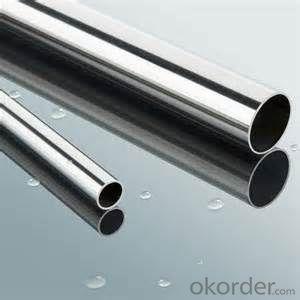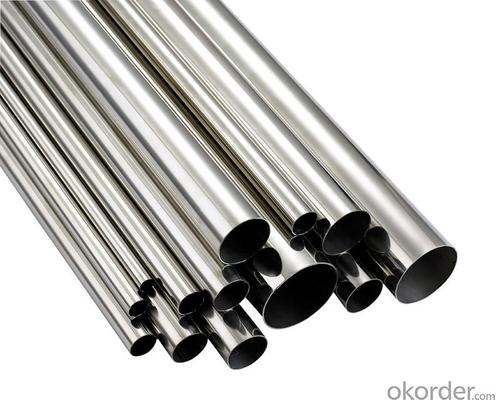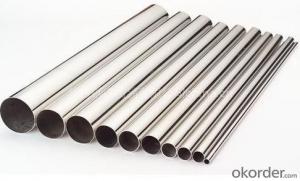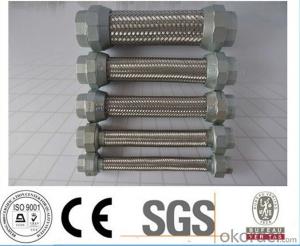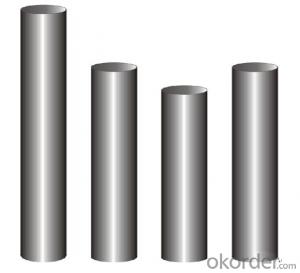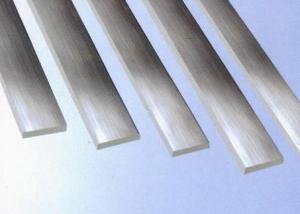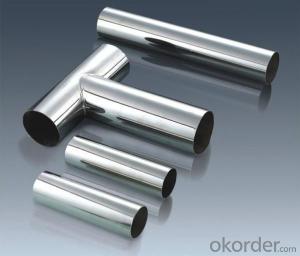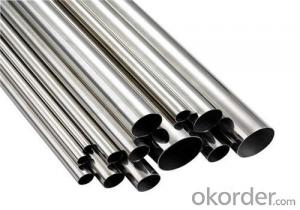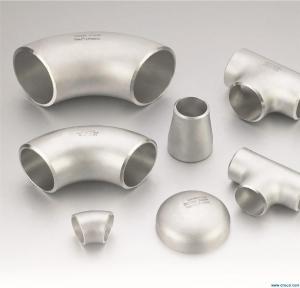STAINLESS STEEL PIPES AND FITTINGS OF 304L MATERIAL
- Loading Port:
- China Main Port
- Payment Terms:
- TT OR LC
- Min Order Qty:
- -
- Supply Capability:
- -
OKorder Service Pledge
OKorder Financial Service
You Might Also Like
Description:
Stainless Steel Pipe
Material:
304 321 316 310
Packing:
In bundle
MOQ:
5 TONS
Comparison of standardized steels
| EN-standard Steel no. k.h.s DIN | EN-standard Steel name | SAE grade | UNS |
|---|---|---|---|
| 1.4109 | X65CrMo14 | 440A | S44002 |
| 1.4112 | X90CrMoV18 | 440B | S44003 |
| 1.4125 | X105CrMo17 | 440C | S44004 |
| | | 440F | S44020 |
| 1.4016 | X6Cr17 | 430 | S43000 |
| 1.4408 | G-X 6 CrNiMo 18-10 | 316 | |
| 1.4512 | X6CrTi12 | 409 | S40900 |
| | | 410 | S41000 |
| 1.4310 | X10CrNi18-8 | 301 | S30100 |
| 1.4318 | X2CrNiN18-7 | 301LN | |
| 1.4307 | X2CrNi18-9 | 304L | S30403 |
| 1.4306 | X2CrNi19-11 | 304L | S30403 |
| 1.4311 | X2CrNiN18-10 | 304LN | S30453 |
| 1.4301 | X5CrNi18-10 | 304 | S30400 |
| 1.4948 | X6CrNi18-11 | 304H | S30409 |
| 1.4303 | X5CrNi18-12 | 305 | S30500 |
| | X5CrNi30-9 | 312 | |
| 1.4541 | X6CrNiTi18-10 | 321 | S32100 |
| 1.4878 | X12CrNiTi18-9 | 321H | S32109 |
| 1.4404 | X2CrNiMo17-12-2 | 316L | S31603 |
| 1.4401 | X5CrNiMo17-12-2 | 316 | S31600 |
| 1.4406 | X2CrNiMoN17-12-2 | 316LN | S31653 |
| 1.4432 | X2CrNiMo17-12-3 | 316L | S31603 |
| 1.4435 | X2CrNiMo18-14-3 | 316L | S31603 |
| 1.4436 | X3CrNiMo17-13-3 | 316 | S31600 |
| 1.4571 | X6CrNiMoTi17-12-2 | 316Ti | S31635 |
| 1.4429 | X2CrNiMoN17-13-3 | 316LN | S31653 |
| 1.4438 | X2CrNiMo18-15-4 | 317L | S31703 |
| 1.4362 | X2CrNi23-4 | 2304 | S32304 |
| 1.4462 | X2CrNiMoN22-5-3 | 2205 | S31803/S32205 |
| 1.4539 | X1NiCrMoCu25-20-5 | 904L | N08904 |
| 1.4529 | X1NiCrMoCuN25-20-7 | | N08926 |
| 1.4547 | X1CrNiMoCuN20-18-7 | 254SMO | S31254 |
Stainless steel’s resistance to corrosion and staining, low maintenance and familiar lustre make it an ideal material for many applications. There are over 150 grades of stainless steel, of which fifteen are most commonly used. The alloy is milled into coils, sheets, plates, bars, wire, and tubing to be used in cookware, cutlery, household hardware, surgical instruments, major appliances, industrial equipment (for example, in sugar refineries) and as an automotive and aerospace structural alloy and construction material in large buildings. Storage tanks and tankers used to transport orange juice and other food are often made of stainless steel, because of its corrosion resistance. This also influences its use in commercial kitchens and food processing plants, as it can be steam-cleaned and sterilized and does not need paint or other surface finishes.
Stainless steel is used for jewelry and watches with 316L being the type commonly used for such applications. It can be re-finished by any jeweler and will not oxidize or turn black.
Some firearms incorporate stainless steel components as an alternative to blued or parkerized steel. Some handgun models, such as the Smith & Wesson Model 60 and the Colt M1911 pistol, can be made entirely from stainless steel. This gives a high-luster finish similar in appearance to nickel plating. Unlike plating, the finish is not subject to flaking, peeling, wear-off from rubbing (as when repeatedly removed from a holster), or rust when scratched.
- Q: Are stainless steel pipes resistant to scaling and pitting?
- Yes, stainless steel pipes are highly resistant to scaling and pitting. Stainless steel is known for its excellent corrosion resistance properties, which make it highly durable and suitable for various applications, including pipe systems. The presence of chromium in stainless steel forms a protective layer of chromium oxide on the surface, preventing the formation of rust and corrosion. This protective layer makes stainless steel pipes highly resistant to scaling, which is the formation of hard mineral deposits on the inner surface of pipes. Additionally, stainless steel pipes are also resistant to pitting, which is the localized corrosion that occurs as small holes or pits on the pipe's surface. Therefore, stainless steel pipes are an ideal choice for industries or applications where corrosion resistance is crucial, such as water distribution systems, chemical processing plants, and oil and gas pipelines.
- Q: Is food grade stainless steel GB9684 304?
- Food grade stainless steel is in line with the GB9684 standard stainless steel.
- Q: Can stainless steel pipes be painted?
- Yes, stainless steel pipes can be painted. However, it is important to note that stainless steel is a non-porous material and has a smooth surface, which can make it challenging for paint to adhere to it effectively. To ensure proper adhesion, it is recommended to clean the surface thoroughly and apply a primer specifically designed for stainless steel. This will help create a rougher texture on the surface, allowing the paint to bond better. Additionally, using a high-quality, durable paint that is suitable for metal surfaces will enhance the longevity of the painted finish.
- Q: Advantages and disadvantages of PPR lined stainless steel pipe and PPR aluminium plastic pipe
- 1 、 excellent resistance to temperature and pressurePP-R tube and aluminum layer organic combination, with higher strength and better temperature resistance, pressure resistance performance, more suitable for high temperature hot water field use2, small thermal expansion deformationThe thermal expansion coefficient is small (3 x 10-5m/m - C), similar to metal pipe, avoid the pipe deformation due to temperature changes, reduce the number of free arm compensation for pipe deformation, is ideal for heating and central air-conditioning system.3, light blocking oxygenThe intermediate aluminum layer is insulated from oxygen to avoid the oxidation and corrosion of the metal parts in the heating and central air conditioning system, thus effectively prolonging the service life of the system.
- Q: Can stainless steel water pipes be cooled and bent?
- Stainless steel pipe is a kind of hollow long strip round steel, mainly used in petroleum, chemical, medical, food, light industry, machinery, instrument and other industrial pipeline and mechanical structure parts.
- Q: Can stainless steel pipes be used for steam applications?
- Yes, stainless steel pipes can be used for steam applications. Stainless steel is known for its high temperature resistance and corrosion resistance, making it suitable for steam systems. It can withstand the high pressure and temperatures that steam applications require without deforming or corroding. Stainless steel pipes are also durable and have a long lifespan, making them a reliable choice for steam applications. Additionally, stainless steel pipes can be easily welded, ensuring a secure and leak-free steam system.
- Q: Can stainless steel pipes be used in extreme weather conditions?
- Yes, stainless steel pipes can be used in extreme weather conditions. Stainless steel is known for its excellent corrosion resistance, which makes it ideal for withstanding harsh weather conditions such as extreme temperatures, high humidity, and exposure to saltwater or chemicals. Additionally, stainless steel pipes have high strength and durability, making them resistant to impact and deformation caused by extreme weather events like storms or earthquakes. Therefore, stainless steel pipes are often chosen for applications in industries such as oil and gas, chemical processing, and marine, where they need to perform reliably in extreme weather conditions.
- Q: Are stainless steel pipes suitable for marine environments?
- Indeed, stainless steel pipes prove to be an excellent choice for marine environments due to their high suitability. With their corrosion and rust resistance, stainless steel emerges as an ideal material for deployment in marine settings, where constant exposure to saltwater, moisture, and other adverse conditions prevails. The inclusion of chromium in stainless steel results in the creation of a protective layer on its surface, effectively preventing the emergence of rust and corrosion. Consequently, these pipes exhibit remarkable longevity and durability, even when subjected to highly corrosive marine environments. Moreover, stainless steel pipes offer outstanding strength and impact resistance, rendering them highly reliable for a multitude of marine applications, including shipbuilding, offshore platforms, and marine structures.
- Q: How do you calculate the weight of a stainless steel pipe?
- In order to determine the weight of a stainless steel pipe, it is necessary to have knowledge of its dimensions and the density of stainless steel. To begin with, the outer diameter (OD) and wall thickness (WT) of the pipe should be measured. To obtain precise measurements, employ a caliper or ruler. Following that, the inner diameter (ID) can be calculated by subtracting twice the wall thickness from the outer diameter. The formula for determining the ID is: ID = OD - 2 * WT. Subsequently, employ the formula A = π * ((OD/2)^2 - (ID/2)^2), where π is approximately 3.14159, to calculate the cross-sectional area (A) of the pipe. Next, locate the density of stainless steel. While the density may slightly differ depending on the specific grade of stainless steel, the average value is approximately 7.9 grams per cubic centimeter (g/cm³) or 7900 kilograms per cubic meter (kg/m³). Lastly, multiply the cross-sectional area (A) by the length of the pipe (L) and the density (D) to determine the weight. The formula for calculating the weight (W) is: W = A * L * D. Ensure that consistent units are used throughout the calculations. For instance, if the length is measured in meters, the weight will be expressed in kilograms. If the length is measured in inches, the weight will be expressed in pounds.
- Q: What is the difference between 430 and 316 stainless steel pipes?
- The composition and properties of 430 and 316 stainless steel pipes differ significantly. 430 stainless steel, a ferritic stainless steel, contains chromium, providing it with good corrosion resistance. However, its resistance to corrosion falls short of that of 316 stainless steel. Furthermore, it has a lower nickel content compared to 316 stainless steel. In contrast, 316 stainless steel is an austenitic stainless steel that encompasses both chromium and nickel. It boasts exceptional corrosion resistance, rendering it suitable for a wide range of applications, particularly in marine environments where exposure to saltwater and other corrosive substances occurs. Additionally, it possesses superior tensile strength and creep resistance in comparison to 430 stainless steel. In terms of appearance, 430 stainless steel features a dull, brushed finish, whereas 316 stainless steel boasts a bright, reflective finish. Given these disparities, the selection between 430 and 316 stainless steel pipes hinges upon the specific application and the desired level of corrosion resistance.
Send your message to us
STAINLESS STEEL PIPES AND FITTINGS OF 304L MATERIAL
- Loading Port:
- China Main Port
- Payment Terms:
- TT OR LC
- Min Order Qty:
- -
- Supply Capability:
- -
OKorder Service Pledge
OKorder Financial Service
Similar products
Hot products
Hot Searches
Related keywords

